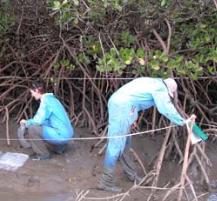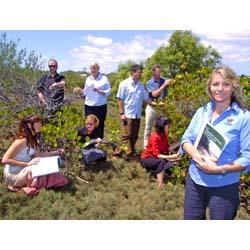CQU helps bid for Smart State funding of Port Curtis monitoring
Published on 11 October, 2006
CQU Gladstone-based researcher Dr Leonie Andersen is coordinating a bid for Queensland Smart Innovation Funds to enhance the work of the Port Curtis Integrated Monitoring Program (PCIMP).
PCIMP undertakes high quality research and monitoring in Port Curtis focusing particularly on contaminants and their effects on the ecosystem. The program was launched in July this year with commencement of its annual water quality and mangrove monitoring.
A workshop was held on Thursday (October 5) to 'scope-up' a range of projects to be submitted as a funding proposal to Queensland Smart Innovation Funds, due to be announced shortly.
"PCIMP members currently commit $600,000 annually to the program and we are looking at using this funding as leverage money to secure $1 million in matching funding from the Queensland Government over 3 years," Dr Andersen said.
 "The funding will be used to increase the calibre of the research in Port Curtis by introducing new technologies and latest techniques to the program, such as remote sensing, hydrodynamic modelling and passive samplers to name a few.
"The funding will be used to increase the calibre of the research in Port Curtis by introducing new technologies and latest techniques to the program, such as remote sensing, hydrodynamic modelling and passive samplers to name a few.
"Researchers will investigate how contaminants move throughout the harbour and if there are measurable effects on the ecosystem. The results will be disseminated to the public through the PCIMP website, which has the potential to be used as an educational tool".
The PCIMP research team consists of a number of researchers from CQU as well as from other institutions such as CSIRO, the universities of Wollongong and Western Australia and Griffith University.
Some of the researchers involved were previous collaborators in the Coastal CRC and were keen to continue the successful research relationship.
Collaborators on PCIMP include:.
Leonie Andersen, CQU – Bioaccumulation & project management.
Felicity Melville, CQU – Mangroves & invertebrates, oil spill.
Larelle Fabbro, CQU – Water physicochemistry, algae.
Peter Teasdale, Griffith University – DGT and sediment chemistry.
Andrew Storey, University of Western Australia – Ecologist and statistician, report card.
Dianne Jolley, University of Wollongong – Sediment chemistry.
Laurie Chisholm, University of Wollongong – PAM and remote sensing.
Karen Danaher, QDPI & F – mangrove mapping.
Simon Apte, CSIRO – Water toxicant chemistry.
Jenny Stauber, CSIRO - Algae.
John Parslow and team, CSIRO – Hydrodynamic modelling.
Other: Clayton Plummer, Lindsay Boyd and CEM research staff.
Thursday's workshop fine-tuned a draft proposal for PCIMP members.
PCIMP, established in 2001, is a consortium of members from 14 bodies representing industry, government (both local and state), research institutions and other stakeholders to develop a cooperative, monitoring program for assessing the ecosystem health of Port Curtis.
PCIMP's vision is to 'foster coordination of monitoring activities among the stakeholders of Port Curtis and to share and disseminate information to improve the capacity to manage natural resources in a sustainable and balanced way for the prosperity of communities and the health of the natural environment'.
Dr Andersen, based at CQU's Centre for Environmental Management in Gladstone, said that through PCIMP, industries and other stakeholders have combined resources to undertake a holistic monitoring and research program, which includes data sharing.
"It is important that a 'whole of port' approach is adopted in the monitoring and assessment of the Gladstone harbour. Previous monitoring has been restricted to individual industry receiving environments, but this will be the first time that such a large collaborative approach to monitoring the whole harbour will be undertaken".
 Latest techniques and emerging technologies will be enlisted to assess the health of the harbour within 7 main research themes; water quality, sediment quality, seagrass, mangroves, macrobenthic invertebrates, bioaccumulation and fish assemblages and fisheries.
Latest techniques and emerging technologies will be enlisted to assess the health of the harbour within 7 main research themes; water quality, sediment quality, seagrass, mangroves, macrobenthic invertebrates, bioaccumulation and fish assemblages and fisheries.
"The type of monitoring being undertaken is above and beyond what industries or members are required to undertake under their licence agreements," Dr Andersen said.
"Taking this into consideration, the level of support for PCIMP is outstanding and demonstrates the commitment of PCIMP members to maintaining a sustainable environment in Port Curtis".
Data will be analysed, collated, interpreted and presented in the form of a Port Curtis Ecosystem Health Report Card and distributed to PCIMP members and the community.
"Eventually we intend to establish a PCIMP website to allow community access to information on the health of the harbour, in the form of colour-coded maps and results in an easy-to-read format," Dr Andersen said.
"Different zones in the harbour will be given a health rating and the information updated each year as results come to hand.
"Industry and other interested stakeholders will be provided with new techniques to manage and sustain the environment as well as a model which demonstrates ways to work in partnership".
Photo (above): Dr Leonie Andersen in the foreground with other research collaborators including Dianne Jolley, Peter Teasdale, Laurie Chisholm, Larelle Fabbro, Simon Apte, Andrew Storey and Felicity Melville. Photo courtesy The Gladstone Observer.
Photo (below): Samples are collected in the mangroves.

